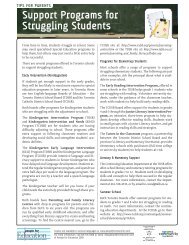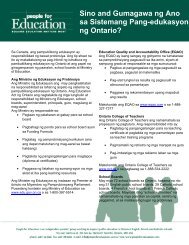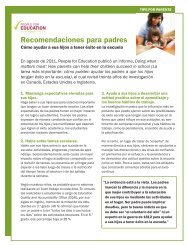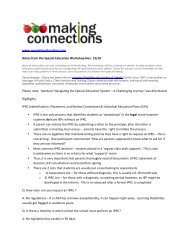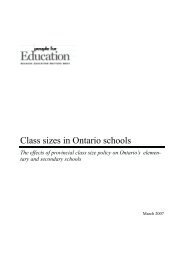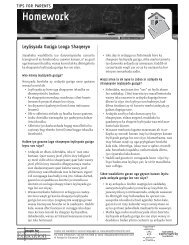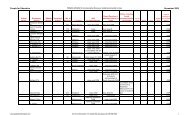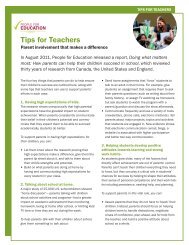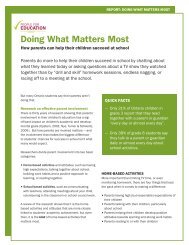Our Children Our Future Our Vision - People for Education
Our Children Our Future Our Vision - People for Education
Our Children Our Future Our Vision - People for Education
You also want an ePaper? Increase the reach of your titles
YUMPU automatically turns print PDFs into web optimized ePapers that Google loves.
<strong>Our</strong> <strong>Children</strong>, <strong>Our</strong> <strong>Future</strong>, <strong>Our</strong> <strong>Vision</strong><br />
sufficient to meet the needs of First Nation communities, while 25.2% had no opinion either way.<br />
Q4: The early childhood education curriculum <strong>for</strong> learners must be adapted by First Nation Early<br />
Childhood educators to reflect local First Nation culture and language. This question reflected the<br />
need to control and determine the curriculum and general program of services implemented in<br />
First Nation centers, with 79.3% responding that they were in full / overwhelmingly in agreement<br />
with the statement, while 13.2% had no opinion either way.<br />
COMMENTS: There were a total of 64 comments in this category, which were coded under the major<br />
themes of Language & Culture (16), Access (16), Funding (7), Curriculum (7), Special <strong>Education</strong><br />
(2), and General Commentary (16).<br />
Access and Language & Culture were the major areas presented by respondents, with sixteen (16)<br />
comments each. Respondents felt that the local First Nations language and culture needed to be an<br />
integral component of the Childcare center in their community. An equal number noted that access<br />
to early learning programs and childcare was important, and that First Nations required better access,<br />
particularly in northern communities.<br />
2. Early Learning – Head Start, K4 & K5<br />
Q1: First Nation schools require access to comparable early learning opportunities to those available<br />
to provincially funded schools. In the area of early learning programs <strong>for</strong> 3, 4, and 5 year olds,<br />
89.5% of the respondents felt that First Nations required access to such programs, and that the<br />
level of programming should be at least comparable to the Junior Kindergarten (JK) and Senior<br />
Kindergarten (SK) programs that are provided in the province.<br />
Q2: Current funding mechanisms are sufficient and need only to be adjusted appropriately to meet<br />
the needs of First Nation early learners as identified by individual First Nation communities. In<br />
the area of funding <strong>for</strong> early learning programs, 74.5% were in total / some disagreement with the<br />
statement that the funding levels were sufficient and only needed to be adjusted, while 15.5% had<br />
no opinion either way.<br />
Q3: The provincial curriculum <strong>for</strong> early learners (K4/K5) must be adapted by First Nation educators<br />
to reflect local First Nation culture and language be<strong>for</strong>e being implemented in the classroom. This<br />
question was in the area of First Nation control over the curriculum and the programs and services<br />
that are offered in these centres, with 76.7% in full / overwhelmingly in agreement with the statement<br />
that there should be adaptation to include local culture and language, while only 9.1% had<br />
no opinion either way.<br />
Chiefs of Ontario<br />
64



